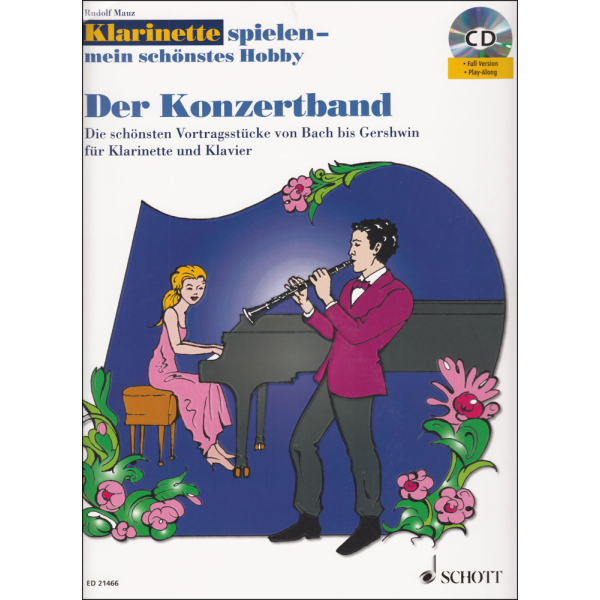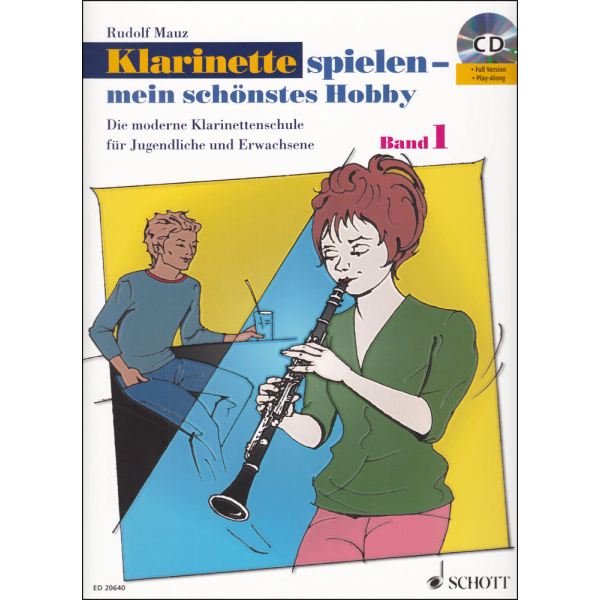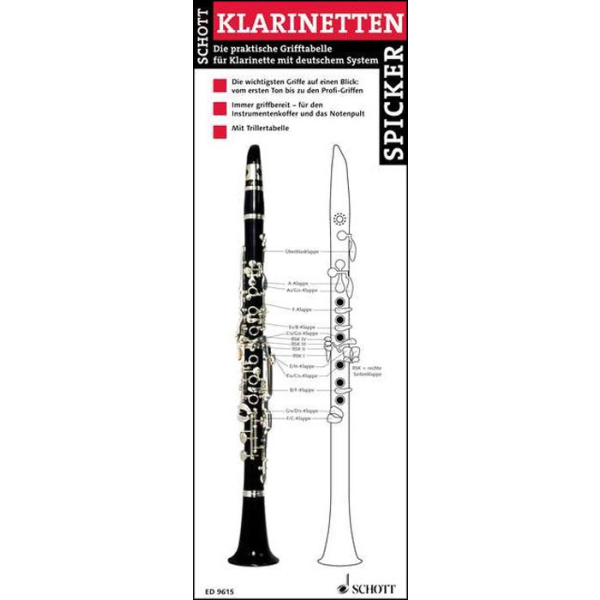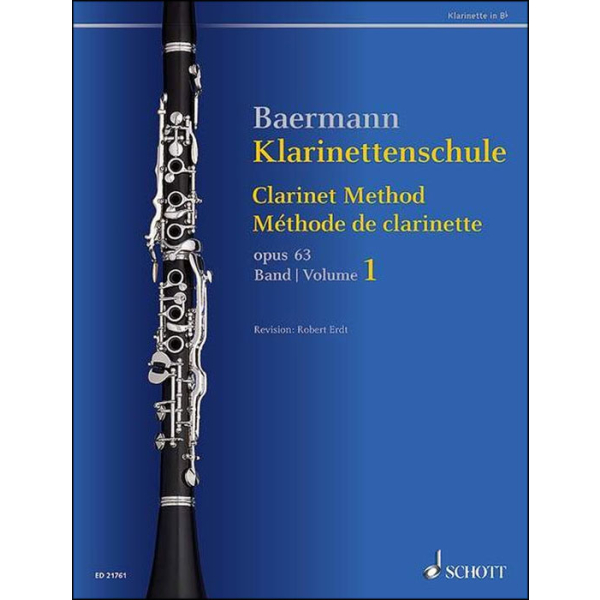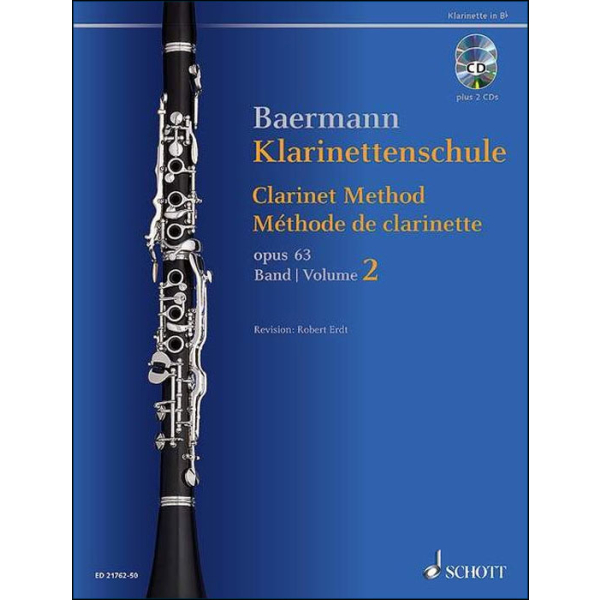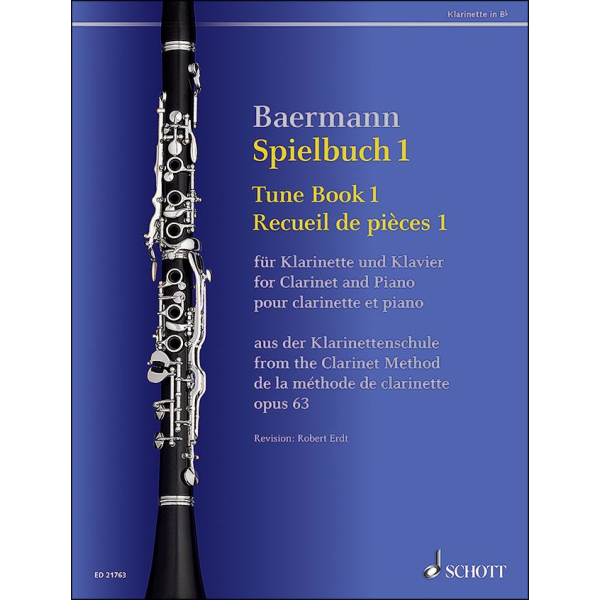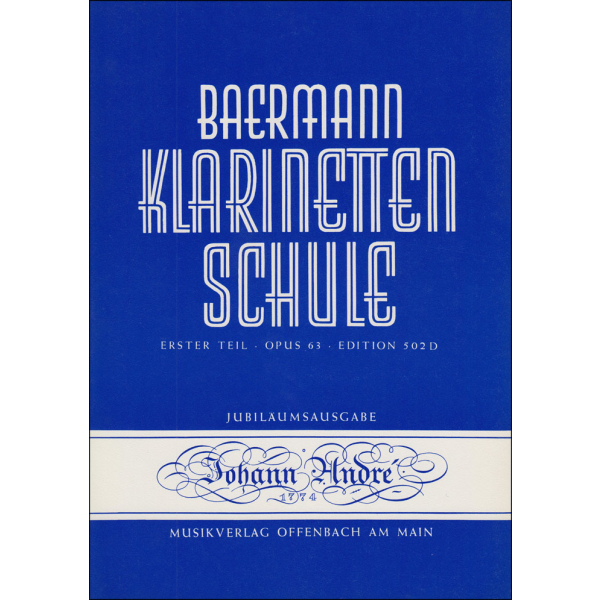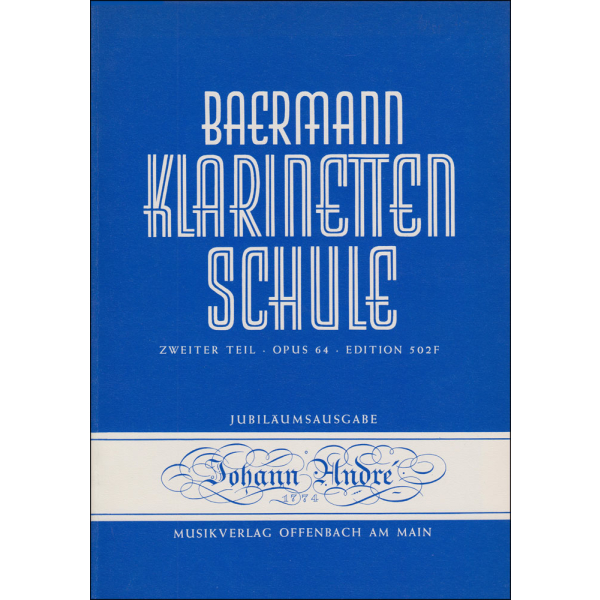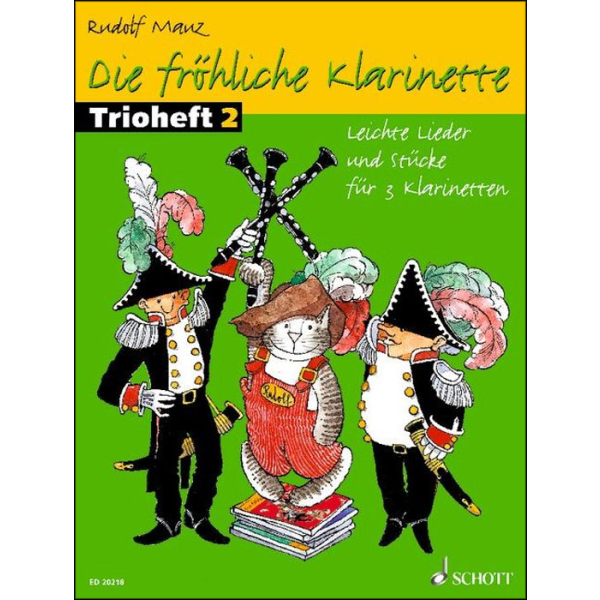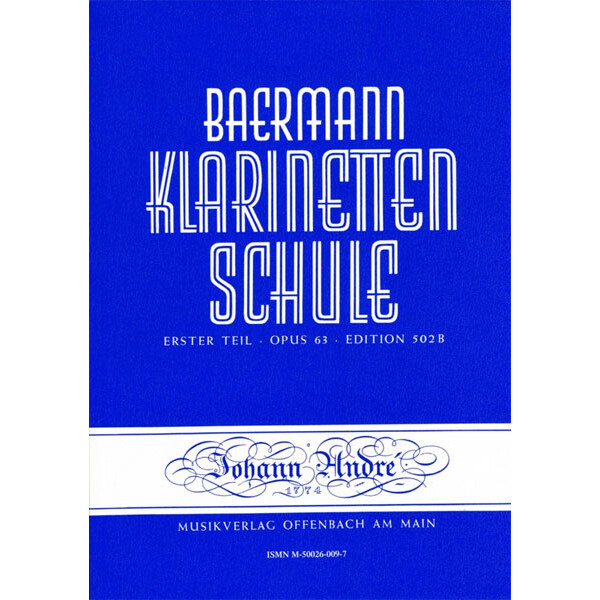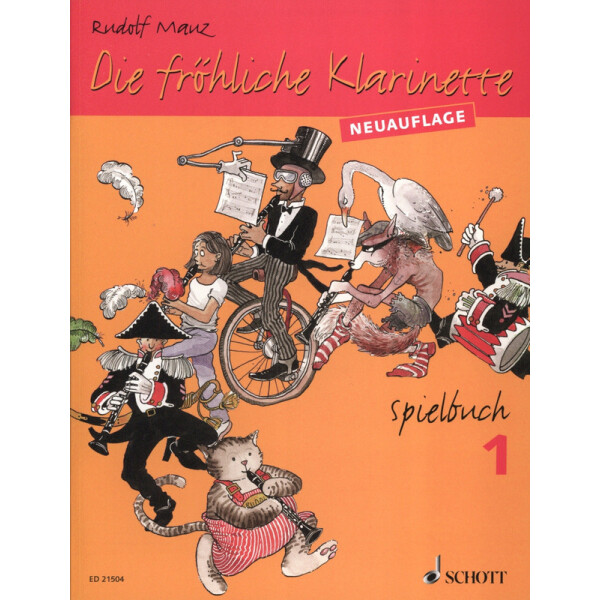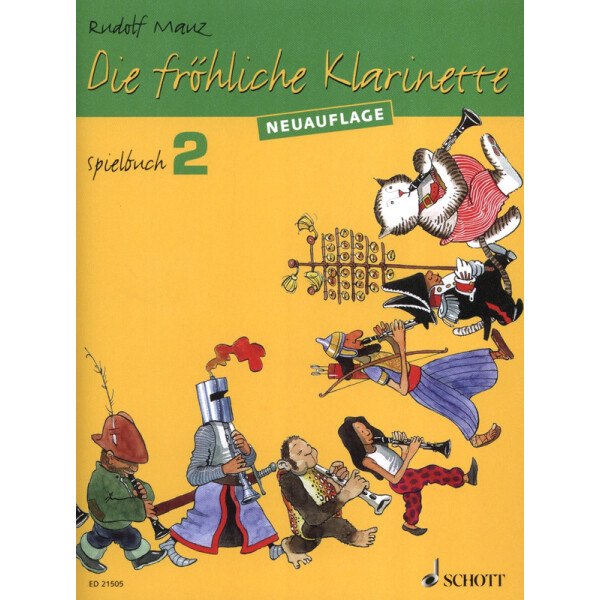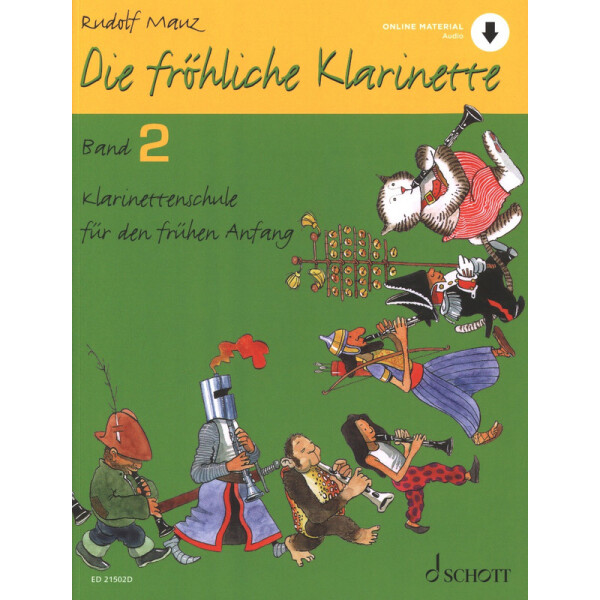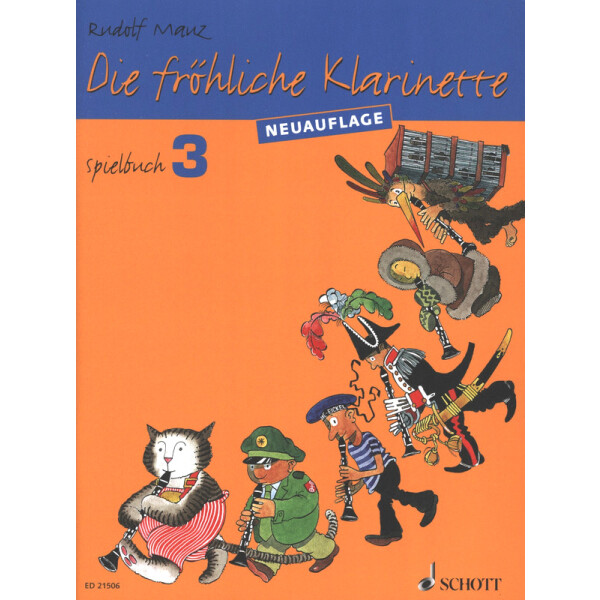Schott
Songbook
Content
C. Baermann: Molto moderato aus der Klarinettenschule, op. 63
H. Both: High School Dixie
R. Mauz: Sehnsucht
C. Debussy: Petite pièce
M. Reger: Romanze in G
J.-X. Lefèvre: Rondo aus der Sonate B-Dur, op. 12
W.A. Mozart: Das Veilchen, KV 476
E. Schulhoff: Susi
F. Tausch: Romanze aus dem Konzert Es-Dur
F. Zehm: Zwei Bagatellen
J.S. Bach: Siciliano aus der Flötensonate Es-Dur BWV 1031
P. Desmond: Take Five
C. Baermann: Romanze
C. Oberthür: Réminiscences de joie
H. Eccles: Grave und Presto aus der Sonate g-Moll für Violine und B.c.
J. Kern/O. Harbach: Smoke gets in your Eyes
E. Satie: Gymnopédie No. 1
G. Gershwin: I got Rhythm
E. Cossetto: Csárdás aus den "Csárdás-Kompositionen"
Manufacturer according to GPSR
Schott Music GmbH & Co. KG, Weihergarten 5, 55116 Mainz, Rheinland-Pfalz, Deutschland, info@schott-music.com, https://www.schott-music.com
Rudolf Mauz: Klarinette spielen - mein schönstes Hobby
Book with CD
Klarinette spielen - mein schönstes Hobby is a new, modern clarinet method
for young people and adults and conveys the learning content in a motivating,
varied and easy to understand style. It is suitable for the German fingering
and the Boehm clarinet.
The clear division into lessons with check boxes and tests facilitates orientation
and helps with learning. The colorful mixture of pieces of music from classical, folk, pop and jazz
ensures that the fun of learning is not lost.
Zahlreiche Duette (beide Stimmen für Schüler geeignet), bewährte Übungen, Improvisationsanregungen
und fundierte Praxistipps, auch zum Instrument, runden die Schule ab.
Ob mit oder ohne Lehrer/in - mit dieser Schule bekommt der Anfänger eine solide Grundlage
im spielerischen Können und theoretischen Wissen. Auch der Wiedereinsteiger kann problemlos seine Kenntnisse auffrischen.
Für Spaß beim Spielen sorgt die beiliegende CD mit vielen Stücken zum Anhören und Mitspielen.
Ob mit Klavierbegleitung oder Band - die Vollversion und Playbacks sind eine ideale Lernhilfe.
Manufacturer according to GPSR
Schott Music GmbH & Co. KG, Weihergarten 5, 55116 Mainz, Rheinland-Pfalz, Deutschland, info@schott-music.com, https://www.schott-music.com
Finger chart for clarinets
Manufacturer according to GPSR
Schott Music GmbH & Co. KG, Weihergarten 5, 55116 Mainz, Rheinland-Pfalz, Deutschland, info@schott-music.com, https://www.schott-music.com
- Audio as
The clarinet method op. 63 by Carl Baermann from 1867 is still a standard work in classical clarinet education today. The thoroughly revised new edition aims at reviewing the educational concept, which is still valid today, for modern lessons, adjusting the music and texts, and sensibly complementing the teaching contents.
The editor who draws on many years of experience as a clarinettist in an orchestra and university lecturer of clarinet has succeeded in adapting the valuable teaching material to the requirements of today while maintaining the basic methodology. The result is a total of 7 volumes:
- Clarinet Method Vol. 1 and Vol. 2 (ED 21761, ED 21762)
- Clarinet Method Vol. 1, with online material (audio), and Vol. 2, with 2 CDs (ED 21761, ED 21762-50): The audios contain the piano accompaniment for the performance pieces, with and without clarinet
- Tune Book 1 and 2 (ED 21763, ED 21764): piano score of the method's performance pieces, with additional inserted clarinet part
- Daily Exercises (ED 21765): systematic scale, interval and chord exercises in all keys, complemented and published separately from the original method
Due to trilingual nature of all editions (German, English, French), they can be used universally.
Manufacturer according to GPSR
Schott Music GmbH & Co. KG, Weihergarten 5, 55116 Mainz, Rheinland-Pfalz, Deutschland, info@schott-music.com, https://www.schott-music.com
The clarinet method op. 63 by Carl Baermann from 1867 is still a standard work in classical clarinet education today. The thoroughly revised new edition aims at reviewing the educational concept, which is still valid today, for modern lessons, adjusting the music and texts, and sensibly complementing the teaching contents.
The editor who draws on many years of experience as a clarinettist in an orchestra and university lecturer of clarinet has succeeded in adapting the valuable teaching material to the requirements of today while maintaining the basic methodology. The result is a total of 7 volumes:
- Clarinet Method Vol. 1 and Vol. 2 (ED 21761, ED 21762)
- Clarinet Method Vol. 1, with online material (audio), and Vol. 2, with 2 CDs (ED 21761, ED 21762-50): The audios contain the piano accompaniment for the performance pieces, with and without clarinet
- Tune Book 1 and 2 (ED 21763, ED 21764): piano score of the method's performance pieces, with additional inserted clarinet part
- Daily Exercises (ED 21765): systematic scale, interval and chord exercises in all keys, complemented and published separately from the original method
Due to trilingual nature of all editions (German, English, French), they can be used universally.
Manufacturer according to GPSR
Schott Music GmbH & Co. KG, Weihergarten 5, 55116 Mainz, Rheinland-Pfalz, Deutschland, info@schott-music.com, https://www.schott-music.com
The clarinet method op. 63 by Carl Baermann from 1867 is still a standard work in classical clarinet education today. The thoroughly revised new edition aims at reviewing the educational concept, which is still valid today, for modern lessons, adjusting the music and texts, and sensibly complementing the teaching contents.
The editor who draws on many years of experience as a clarinettist in an orchestra and university lecturer of clarinet has succeeded in adapting the valuable teaching material to the requirements of today while maintaining the basic methodology. The result is a total of 7 volumes:
- Clarinet Method Vol. 1 and Vol. 2 (ED 21761, ED 21762)
- Clarinet Method Vol. 1 and Vol. 2, with 2 CDs each (ED 21761-50, ED 21762-50): The CDs contain the piano accompaniment for the performance pieces, with and without clarinet
- Tune Book 1 and 2 (ED 21763, ED 21764): piano score of the method's performance pieces, with additional inserted clarinet part
- Daily Exercises (ED 21765): systematic scale, interval and chord exercises in all keys, complemented and published separately from the original method
Due to trilingual nature of all editions (German, English, French), they can be used universally.
Manufacturer according to GPSR
Schott Music GmbH & Co. KG, Weihergarten 5, 55116 Mainz, Rheinland-Pfalz, Deutschland, info@schott-music.com, https://www.schott-music.com
Baermann: Klarinettenschule op. 63 Erster Teil
Practical part
Carl Baermann's clarinet method is a very detailed, competent textbook.
The first part is divided into a "theoretical part with fingering chart", the "beginning of the practical school",
a part with a wide range of daily exercises and a volume with the piano accompaniment.
The second part op. 64 is the continuation of the piano accompaniments.
This volume is intended to provide an introduction to active music-making. Of course, a certain theoretical
Previous training is always necessary: ??the theoretical knowledge acquired (from the first part) can be used
Put students into practice in this part. Of course, these learning steps can also be more or less
happen simultaneously. Exact and understandable explanations for the execution of the individual exercises are given.
In the various scale exercises and arpeggios, the budding musician can gradually learn how to play his instrument
explore and train their skills.
Baermann: Klarinettenschule op. 64 Zweiter Teil - piano accompaniment
trio book - Vol.2
The playing books for the Mauz clarinet school are of pitch range,
Dynamics and articulation are tailored to the schools.
They offer additional playing material for clarinet and piano as well as for 2 or 3 clarinets.
Manufacturer according to GPSR
Schott Music GmbH & Co. KG, Weihergarten 5, 55116 Mainz, Rheinland-Pfalz, Deutschland, info@schott-music.com, https://www.schott-music.com
Baermann: Klarinettenschule op. 63 Erster Teil
Practical part
Carl Baermann's clarinet method is a very detailed, competent textbook.
The first part is divided into a "theoretical part with fingering chart", the "beginning of the practical school",
a part with a wide range of daily exercises and a volume with the piano accompaniment.
The second part op. 64 is the continuation of the piano accompaniments.
This volume is intended to provide an introduction to active music-making. Of course, a certain theoretical
Previous training is always necessary: ??the theoretical knowledge acquired (from the first part) can be used
Put students into practice in this part. Of course, these learning steps can also be more or less
happen simultaneously. Exact and understandable explanations for the execution of the individual exercises are given.
In the various scale exercises and arpeggios, the budding musician can gradually learn how to play his instrument
explore and train their skills.
Das Spielbuch zu "Die fröhliche Klarinette 1"
The playing books for the Mauz clarinet school are of pitch range,
Dynamics and articulation are tailored to the schools.
They offer supplementary playing material for clarinet and piano as well
for 2 or 3 clarinets. Some pieces have been added to the new edition
and renewed the appearance with a modern typography.
Manufacturer according to GPSR
Schott Music GmbH & Co. KG, Weihergarten 5, 55116 Mainz, Rheinland-Pfalz, Deutschland, info@schott-music.com, https://www.schott-music.com
Die fröhliche Klarinette - Klarinettenschule Band 1
with Download Code
by Rudolf Mauz
The new edition of the Mauz Clarinet School retains the proven system of the previous one
Issue included, but appears in a revised overall picture. Modern typography
and revised texts make the layout more appealing, and popular plays became popular
and updated photos.
Die Schule für Deutsches- und Böhm-System richtet sich an die Anfänger heutiger
Generationen und ist für den Einzel- und Gruppenunterricht geeignet. Sie erscheint
in drei Bänden, zu denen jeweils auch ein Spielbuch vorgelegt wird.
Durch leichte Verständlichkeit, die Auswahl von zahlreichen Liedern sowie durchgehend
vierfarbige Illustrationen sollen gezielt jüngere Klarinettenschüler ab etwa 8 Jahren
angesprochen werden. Band 1: Ausführliche Behandlung des tiefen Registers. Einführung
der Dynamik und erstes Überblasen.
- Herzlich willkommen
- Mundstück und Blatt
- Die Haltung
- Übung macht den Meister
- Der Ansatz
- Aller Anfang ist leicht
- Der Ton macht die Musik
- Das Anstoßen
- Die Atmung
- Notenwerte und Pausen
- Melodien aus vier Ländern
- Takt und Metrum
- Ein neuer Ton: das h
- Ein neuer Ton: das a
- Legatospiel
- Die Einspielseite
- Ein neuer Ton: das tiefe g
- Das f
- Ein Wort zum Üben
- Das eingestrichene a
- Die Achtelnote
- Der Auftakt
- Wir spielen Kanons
- Das Kreuz
- Unsere ersten Tonleiter: G-Dur
- Die punktierte Viertelnote
- Die Dynamik
- Etwas Theorie
- Das b
- F-Dur-Tonleiter und Dreiklang
- Besuch im Musikgeschäft
- Das Überblasen
- Meine Lieblingsstücke
- Grifftabelle für die Deutsche Klarinette
- Grifftabelle für die Böhm-Klarinette
Manufacturer according to GPSR
Schott Music GmbH & Co. KG, Weihergarten 5, 55116 Mainz, Rheinland-Pfalz, Deutschland, info@schott-music.com, https://www.schott-music.com
Das Spielbuch zu Die fröhliche Klarinette 2
The playing books for the Mauz clarinet school are of pitch range,
Dynamics and articulation are tailored to the schools.
They offer additional playing material for clarinet and piano as well as for 2 or 3 clarinets.
Manufacturer according to GPSR
Schott Music GmbH & Co. KG, Weihergarten 5, 55116 Mainz, Rheinland-Pfalz, Deutschland, info@schott-music.com, https://www.schott-music.com
Die fröhliche Klarinette - Klarinettenschule Band 2
with Download Code
by Rudolf Mauz
Proven system in a new guise: the new edition of the clarinet method is included
modern typography, revised lyrics, additional popular tracks and new ones
appealing layout. The school for the German and Boehm system is aimed at the
Beginners of today's generation and is suitable for individual and group lessons.
It appears in three volumes, each with a playbook.
Through easy understandability, the selection of numerous songs as well as throughout
four-color illustrations, she specifically addresses younger clarinet students from around 8 years of age.
- Fröhlicher Anfang
- Das Überblasen
- Wir wiederholen Tonleitern und Dreiklänge
- Das Abdecken
- Die F-Dur-Tonleiter über zwei Oktaven
- Die C-Dur-Tonleiter
- Die Sechzehntelnote
- Die G-Dur-Tonleiter über zwei Oktaven
- Das Staccato
- Die a-Moll-Tonleitern
- Die acht Übegesetze
- Der Alla-Breve-Takt
- Vom Musikrohr" zum Klarinettenblatt
- Die enharmonische Verwechslung
- Die D-Dur-Tonleiter
- Die Es-Dur-Tonleiter
- Die A-Dur-Tonleiter über zwei Oktaven
- Die Synkope
- Die e-Moll-Tonleitern
- Die C-Dur-Tonleiter über zwei Oktaven
- Tonleitern und Dreiklänge
- Einige musikalische Zeichen und Anweisungen
- Meine Lieblingsstücke
- Grifftabelle für die Deutsche Klarinette
- Grifftabelle für die Böhm-Klarinette
Manufacturer according to GPSR
Schott Music GmbH & Co. KG, Weihergarten 5, 55116 Mainz, Rheinland-Pfalz, Deutschland, info@schott-music.com, https://www.schott-music.com
Manufacturer according to GPSR
Schott Music GmbH & Co. KG, Weihergarten 5, 55116 Mainz, Rheinland-Pfalz, Deutschland, info@schott-music.com, https://www.schott-music.com

